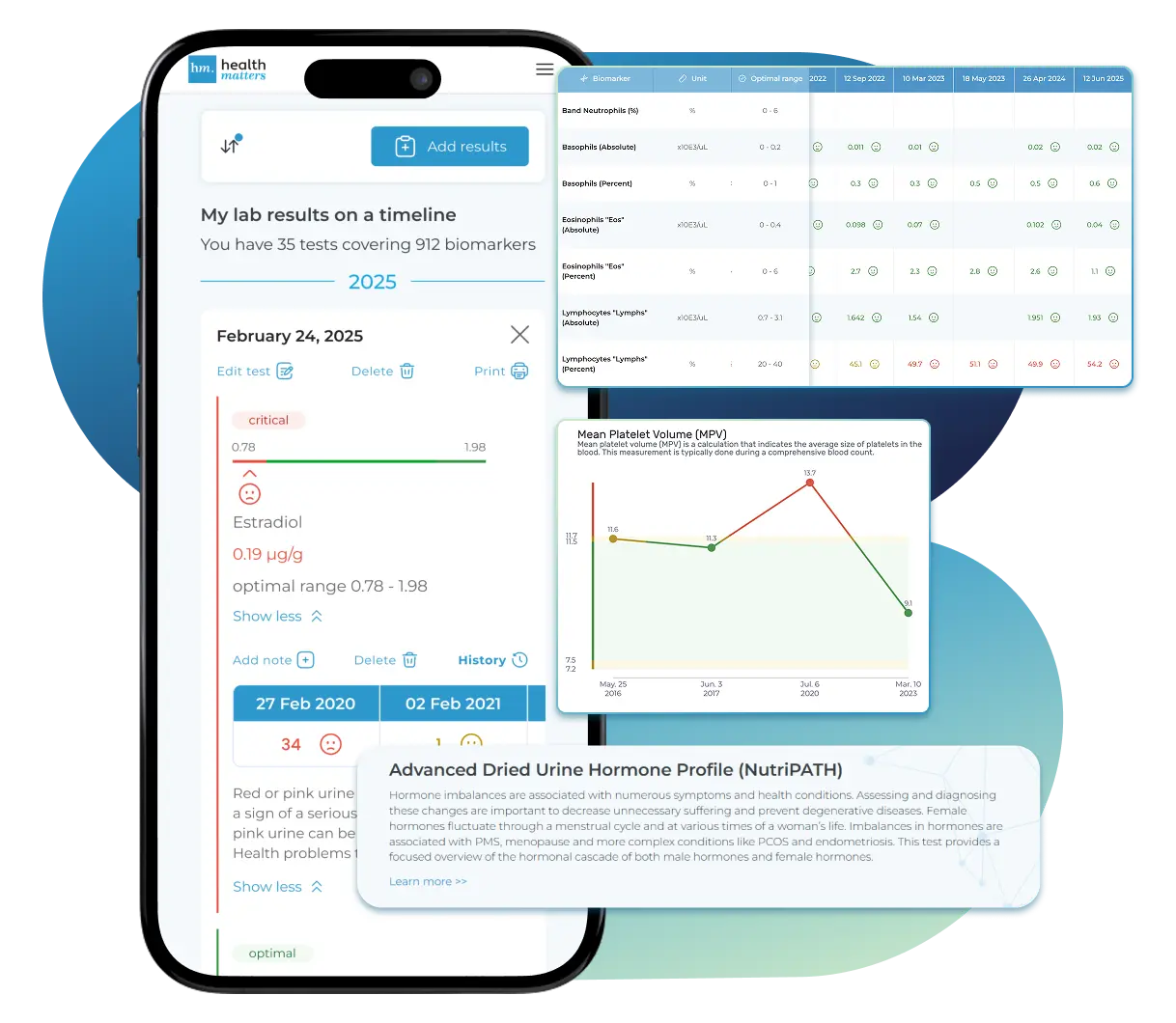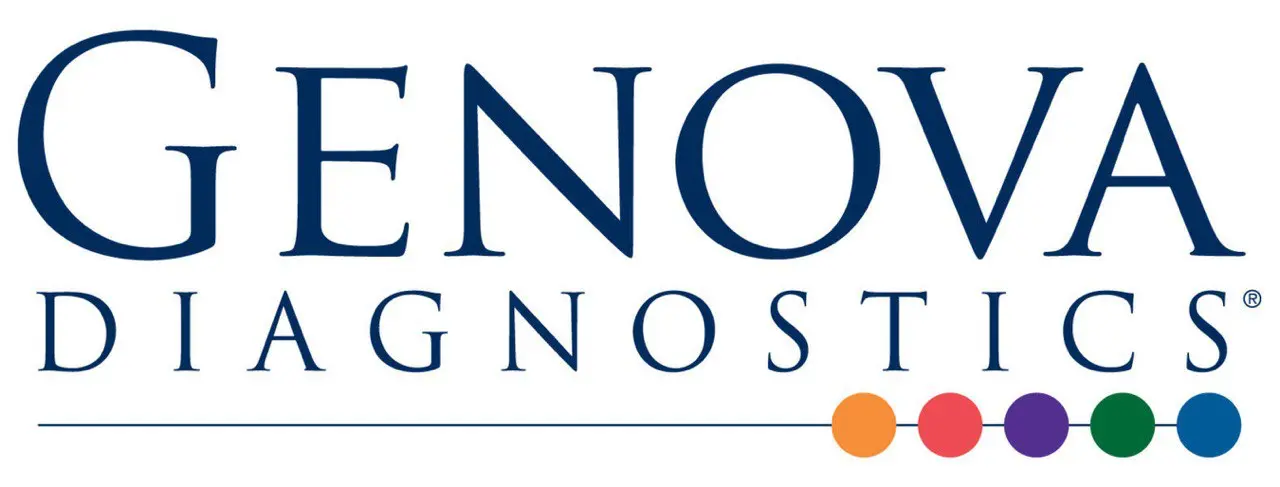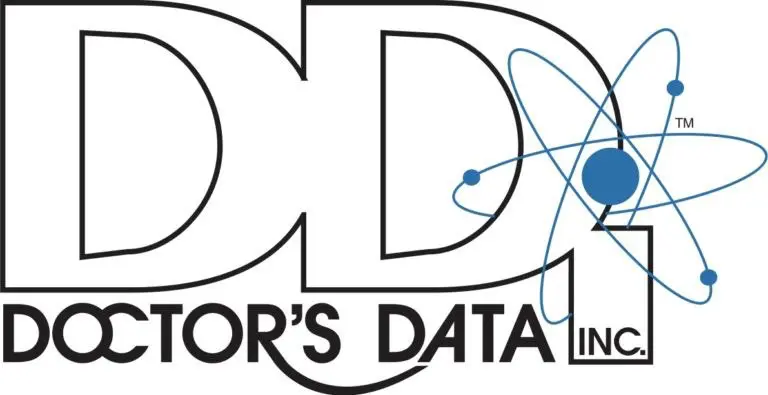Quinolinic acid is a key intermediate in the kynurenine pathway, the primary route by which the amino acid tryptophan is metabolized into nicotinamide adenine dinucleotide (NAD+)—a molecule essential for cellular energy, mitochondrial function, and redox balance. Although it plays an important physiological role as a precursor for NAD+ synthesis, quinolinic acid can become neurotoxic when produced in excess, contributing to oxidative stress, inflammation, and excitatory neurochemical imbalances.
On the Neurotransmitter XL panel, quinolinic acid serves as a sensitive biomarker of chronic stress, immune activation, mitochondrial dysfunction, and neuroinflammation. When tryptophan metabolism is shifted toward the kynurenine pathway—typically by inflammation or cortisol—quinolinic acid levels may rise. This metabolite’s dual nature makes it both vital and potentially harmful: necessary for energy metabolism but detrimental when uncontrolled.
Under normal conditions, quinolinic acid is produced in small, regulated amounts as part of the NAD+ biosynthetic process. The final enzymatic conversion of quinolinic acid into NAD+ requires quinolinate phosphoribosyltransferase (QPRT), an enzyme dependent on adequate magnesium, niacin, and mitochondrial integrity.
In balanced metabolism, this pathway supports:
NAD+ synthesis for mitochondrial ATP production.
Cellular repair and redox control.
Energy-demanding processes such as DNA maintenance, neurotransmitter regulation, and detoxification.
However, when inflammation, oxidative stress, or nutrient deficiencies impair QPRT or downstream conversion, quinolinic acid can accumulate, triggering neurotoxic and pro-oxidative effects.
Quinolinic acid sits at a crucial intersection between inflammation, mitochondrial energy metabolism, and nervous system health. Elevated or imbalanced levels offer key diagnostic clues about the body’s internal stress and immune state. Specifically, it helps identify whether:
The kynurenine pathway is overactivated by inflammatory cytokines (e.g., interferon-γ).
Mitochondrial conversion to NAD+ is impaired, leading to toxic buildup.
Chronic stress or infection has shifted tryptophan away from serotonin toward stress metabolism.
Cofactor deficiencies (B3, magnesium, or zinc) are slowing NAD+ synthesis.
When interpreted alongside tryptophan, kynurenine, NAD+, neopterin, and serotonin, quinolinic acid offers one of the most complete pictures of how stress and inflammation affect both the brain and body energy systems.
Quinolinic acid rises through a convergence of stress-related and inflammatory processes that activate the enzymes indoleamine 2,3-dioxygenase (IDO) and kynurenine monooxygenase (KMO)—driving tryptophan metabolism down a pro-oxidative path.
Cytokines such as interferon-γ, TNF-α, and IL-6 upregulate IDO and KMO.
Activated immune cells (especially macrophages and microglia in the brain) produce quinolinic acid as part of the inflammatory response.
Elevated neopterin levels often accompany this pattern, confirming immune involvement.
When QPRT, the enzyme that converts quinolinic acid to NAD+, is impaired—often due to mitochondrial dysfunction, oxidative stress, or environmental toxin exposure (e.g., phthalates)—quinolinic acid accumulates.
This buildup reduces NAD+ availability, lowering ATP production and contributing to chronic fatigue, cognitive decline, and mood instability.
Conversion of quinolinic acid to NAD+ requires niacin (vitamin B3) and magnesium.
Deficiencies in vitamin B6, folate, or iron also slow related reactions in the kynurenine pathway, leading to partial blockages and excess quinolinic acid.
Quinolinic acid can generate reactive oxygen species (ROS) and nitric oxide (NO), amplifying oxidative stress.
This contributes to mitochondrial damage, enzyme inhibition, and impaired detoxification cycles.
Prolonged stress elevates cortisol and indirectly increases kynurenine and quinolinic acid through TDO activation.
This metabolic shift reduces serotonin synthesis while enhancing neurotoxic and energy-draining metabolites.
Excess quinolinic acid acts as an NMDA receptor agonist, overstimulating excitatory glutamate receptors in the central nervous system. This can result in:
Neuroinflammation and excitotoxicity (nerve cell overstimulation and oxidative damage).
Sleep disturbances and anxiety, due to excessive neural excitation.
Mood disorders such as depression, linked to serotonin depletion and increased inflammation.
Fatigue and cognitive slowing, caused by reduced NAD+ synthesis and mitochondrial impairment.
Chronic pain sensitivity, as quinolinic acid disrupts neuronal signaling and amplifies inflammatory pain pathways.
Over time, excessive quinolinic acid contributes to a “burnout” state—where both neurotransmitter balance and mitochondrial energy output are compromised.
Though less common, low quinolinic acid may indicate:
Low tryptophan availability (dietary deficiency or poor absorption).
Reduced IDO/TDO activity, often from low cortisol or immune suppression.
Impaired kynurenine pathway activation or low enzyme expression.
Inadequate stress or immune signaling leading to underactive metabolism.
In such cases, low quinolinic acid often parallels low NAD+, suggesting reduced mitochondrial output rather than inflammation.
| Related Marker | Interpretation Insight |
|---|---|
| Tryptophan | Low tryptophan with high quinolinic acid indicates chronic inflammation and excessive tryptophan diversion. |
| Kynurenine | Elevated kynurenine with high quinolinic acid suggests overactive IDO/KMO enzyme activity. |
| NAD+ | Low NAD+ alongside high quinolinic acid implies blocked conversion, possibly from cofactor deficiency or mitochondrial dysfunction. |
| Neopterin | Elevated levels confirm immune activation (interferon-γ–mediated). |
| Serotonin | Low serotonin combined with high quinolinic acid reflects tryptophan depletion and neurotransmitter imbalance. |
| Lactate / Pyruvate / Citrate | Abnormal levels indicate mitochondrial energy disruption secondary to oxidative stress. |
Together, these markers allow clinicians to determine whether quinolinic acid elevation results from inflammation, stress-driven enzymatic activation, nutrient depletion, or mitochondrial overload.
Persistent quinolinic acid elevation can contribute to:
Chronic fatigue and low energy (due to NAD+ depletion).
Cognitive fog, irritability, or mood swings.
Depressive symptoms and anxiety (linked to low serotonin and neurotoxicity).
Neurodegenerative stress from excitatory overactivation.
Sleep and circadian rhythm disturbances (from impaired melatonin balance).
Heightened oxidative and nitrosative stress, accelerating cellular aging.
Because of its broad systemic effects, quinolinic acid is a key marker of the biochemical interface between stress, inflammation, and energy metabolism.
Focus on anti-inflammatory nutrients such as curcumin, omega-3 fatty acids (DHA/EPA), resveratrol, and berberine.
Address underlying infections or immune triggers that elevate interferon-γ.
Support the gut barrier to reduce endotoxin-related immune activation.
Replete niacin (vitamin B3) and magnesium to support QPRT function and NAD+ synthesis.
Consider NAD+ precursors like nicotinamide riboside (NR) or NMN, under medical guidance.
Support mitochondrial health with CoQ10, alpha-lipoic acid, L-carnitine, and antioxidants.
Moderate exercise enhances kynurenine aminotransferase (KAT) activity, shifting metabolism toward kynurenic acid (neuroprotective) rather than quinolinic acid (neurotoxic).
Manage chronic stress to reduce cortisol and TDO stimulation.
Ensure sufficient vitamins B6, B12, folate, iron, and zinc, as deficiencies can slow safe tryptophan-to-NAD+ conversion.
Support GABA activity with calming botanicals such as valerian, passionflower, or magnesium glycinate to offset excitotoxic stress.
Quinolinic acid is a critical yet delicate metabolite—vital for NAD+ production but harmful in excess. Elevated levels indicate inflammatory activation of the kynurenine pathway, leading to neurotoxicity, oxidative stress, and mitochondrial dysfunction, while low levels may reflect suppressed metabolism or nutrient insufficiency.
On the Neurotransmitter XL panel, quinolinic acid—interpreted alongside tryptophan, kynurenine, NAD+, neopterin, and serotonin—provides a deep look into the body’s stress–inflammation–energy axis.

Import lab results from multiple providers, track changes over time, customize your reference ranges, and get clear explanations for each result. Everything is stored securely, exportable in one organized file, and shareable with your doctor—or anyone you choose.
Cancel or upgrade anytime

A low quinolinic acid level on the Neurotransmitter XL panel suggests that the tryptophan–kynurenine–NAD+ pathway is underactive or insufficiently engaged. Because quinolinic acid is an essential intermediate in the body’s conversion of tryptophan to NAD+ (nicotinamide adenine dinucleotide)—a key cofactor for mitochondrial energy metabolism—low levels often reflect reduced cellular energy turnover, limited enzyme activity, or nutrient deficiencies required for proper conversion.
While elevated quinolinic acid is associated with inflammation and oxidative stress, low levels may indicate inadequate substrate availability or suppressed metabolic activity, resulting in impaired NAD+ synthesis and reduced mitochondrial performance. This can lead to fatigue, low stress tolerance, and poor recovery at the cellular level.
Quinolinic acid is produced in the kynurenine pathway, which metabolizes tryptophan through a series of enzymatic steps to ultimately generate NAD+, the molecule central to redox balance and energy metabolism.
The enzymes indoleamine 2,3-dioxygenase (IDO) and tryptophan 2,3-dioxygenase (TDO) convert tryptophan into kynurenine.
Kynurenine then progresses through multiple enzymatic reactions—some of which depend on vitamin B6, niacin (B3), magnesium, zinc, and iron—to form quinolinic acid.
Finally, quinolinic acid is converted to NAD+ via quinolinate phosphoribosyltransferase (QPRT).
If any part of this chain is slowed, blocked, or starved of cofactors, quinolinic acid levels may fall below optimal ranges, indicating a downregulated or inefficient NAD+ synthesis pathway.
When upstream precursors like tryptophan or kynurenine are depleted, less substrate is available for quinolinic acid production. This is often seen in:
Low dietary protein intake
Malabsorption or gut inflammation reducing amino acid absorption
Stress-related depletion of tryptophan diverted to serotonin or immune pathways
Chronic undernutrition or restrictive diets
Low quinolinic acid can occur when IDO or TDO, the rate-limiting enzymes initiating the kynurenine pathway, are underactive. Causes include:
Low cortisol output (adrenal insufficiency or HPA-axis suppression)
Blunted immune activation or reduced interferon-γ signaling
Excess antioxidant or anti-inflammatory use, which may suppress normal immune enzyme function
This pattern reflects a body not mounting a typical stress or immune response—sometimes seen in burnout, chronic fatigue, or immune exhaustion.
The kynurenine-to-quinolinic acid pathway relies on several micronutrients to function efficiently:
Vitamin B6 – for enzymatic conversions along the pathway
Niacin (vitamin B3) – regulates NAD+ synthesis and pathway feedback
Iron and zinc – critical for enzyme activity
Magnesium – supports mitochondrial reactions and QPRT enzyme function
Deficiencies in these nutrients slow conversion rates, leading to low quinolinic acid and low NAD+.
Because quinolinic acid conversion to NAD+ occurs in the mitochondria, poor mitochondrial health can create feedback inhibition—reducing production even upstream. When ATP levels are low, the body may downregulate NAD+ synthesis to conserve resources, resulting in low quinolinic acid.
This pattern is common in chronic fatigue, low thyroid function, or metabolic slowdown.
An imbalanced gut microbiome can reduce the availability of tryptophan and its conversion through the kynurenine pathway. Certain bacteria metabolize tryptophan into indoles rather than kynurenine derivatives, lowering quinolinic acid output. Gut inflammation and dysbiosis may also suppress local IDO activity.
While high quinolinic acid is linked to inflammation, too little immune signaling can result in underactivation of the kynurenine pathway. This can occur when inflammation is excessively suppressed by:
Chronic use of corticosteroids or NSAIDs
High-dose antioxidant or anti-inflammatory supplements
Long-term immune-suppressive therapies
In such cases, the pathway remains inactive, and NAD+ synthesis slows.
Low quinolinic acid reflects reduced metabolic throughput rather than toxicity, but the downstream consequences can be equally significant. Common symptoms include:
Persistent fatigue or low energy
“Burned out” sensation or low stress resilience
Brain fog, slow cognition, and low motivation
Mood flatness or mild depression (linked to low NAD+ and serotonin balance)
Slow recovery after stress or exertion
Cold intolerance or sluggish metabolism
These symptoms often overlap with those of low NAD+ or impaired mitochondrial function.
| Related Marker | Interpretation Insight |
|---|---|
| Tryptophan | Low tryptophan with low quinolinic acid suggests precursor deficiency; normal tryptophan with low quinolinic acid points to low enzyme activity. |
| Kynurenine | Low kynurenine and quinolinic acid together indicate pathway underactivation. |
| NAD+ | Low NAD+ alongside low quinolinic acid implies inefficient energy metabolism or nutrient limitation. |
| Neopterin | Low or normal neopterin suggests reduced immune activation or cytokine signaling. |
| Serotonin | May be elevated relative to quinolinic acid if tryptophan is being preferentially converted toward serotonin rather than energy metabolism. |
Interpreting quinolinic acid in this context helps distinguish nutrient-related metabolic sluggishness from pathway overactivation due to inflammation.
Low quinolinic acid may reflect:
Underactive NAD+ production, leading to cellular energy deficits.
Mitochondrial slowdown, affecting metabolism, brain function, and recovery.
Low immune responsiveness, seen in chronic stress or immune exhaustion.
Reduced redox capacity, lowering resistance to oxidative damage.
Neurotransmitter imbalance, with serotonin favored over NAD+ synthesis.
Over time, this pattern can contribute to low vitality, mood dysregulation, and poor physical resilience.
Replenish niacin (B3), magnesium, vitamin B6, zinc, and iron.
Support mitochondrial metabolism with CoQ10, alpha-lipoic acid, L-carnitine, and ribose.
Consider NAD+ precursors such as nicotinamide riboside (NR) or NMN under medical guidance.
Ensure sufficient protein intake and amino acid balance.
Correct gut dysbiosis to improve tryptophan absorption and metabolism.
Manage chronic stress to maintain balanced IDO/TDO activity.
Avoid over-suppressing inflammation unless clinically necessary.
Support balanced immune activity with vitamin D, omega-3 fatty acids, and moderate physical activity.
Replenish antioxidants such as glutathione, vitamin C, and selenium.
Limit exposure to environmental toxins and heavy metals that inhibit mitochondrial enzymes.
Low quinolinic acid suggests a sluggish or underactive kynurenine pathway, often due to nutrient deficiency, mitochondrial inefficiency, or low enzyme activity rather than inflammation. This pattern typically points to impaired NAD+ synthesis, resulting in low energy, fatigue, and reduced resilience.
Interpreting quinolinic acid alongside tryptophan, kynurenine, NAD+, and neopterin on the Neurotransmitter XL panel helps clarify whether low levels stem from metabolic slowdown, poor nutrient availability, or suppressed immune signaling.
Laboratories
We accept reports from any lab, so you can easily collect and organize all your health information in one secure spot.











Pricing Table
Choose the plan that fits you — and turn scattered lab reports into clear insights you can finally use.
Pick a plan that fits you — and turn scattered lab reports into clarity.
Personal plans
Professional plan
$15/ month
Access your lab reports, explanations, and tracking tools.
$250/ once
Pay once, access everything—no monthly fees, no limits.
Professional plan
$45/ month
Designed for professionals managing their clients' lab reports
About membership
 Import Lab Results from Any Source
Import Lab Results from Any Source
Easily upload lab results from any provider, whether it's a hospital, independent lab, or home testing service. We support PDFs, scanned documents, and JPEGs from patient portals. No need to log in to multiple platforms — everything is centralized in one secure space.
Easily upload lab results from any provider — we support PDFs, scans, and images. Keep all your reports organized in one secure place.
 See Your Health Timeline
See Your Health Timeline
Every lab result is automatically organized on a chronological timeline, giving you a complete picture of your health journey. Whether you're tracking a condition, managing treatments, or staying proactive, the timeline helps you and your doctor understand how things progress over time.
Every lab result is automatically organized on a chronological timeline, giving you a complete picture of your health journey.
 Understand What Your Results Mean
Understand What Your Results Mean
Whether it's a blood test, GI panel, urinalysis, or something else, lab reports measure numerous biomarkers that reveal what's happening inside your body. Our extensive database covers over 10,000 biomarkers, providing clear, simple explanations of what each result means and how you can take action—no matter your membership level. Say goodbye to confusion and get the insights you need to better understand your health.
Our database covers over 10,000 biomarkers with clear, simple explanations—so you can finally understand your results and what to do next.
 Enter Your Lab Reports Yourself — Always Free
Enter Your Lab Reports — Always Free
Enter Your Lab Reports Yourself — Always Free
Enter Your Lab Reports — Always Free
If you'd like to handle inputting your health data into your account, you can do so with our easy-to-use data entry forms. Our user-friendly form is designed to guide you through the quick and easy submission process, making it simple to keep track of your health metrics. This is available to both Complete plan and Unlimited plan members.
Our user-friendly form guides you through a quick, simple submission process, making it easy to enter your health metrics.
Add your results anytime with our easy entry form. It's quick, guided, and helps you stay organized — free for all members.
 Visualize Your Results
Visualize Your Results
View your lab data through easy-to-read graphs and tables. Quickly spot patterns, track changes, and compare results across different dates — all without digging through multiple reports. You can also select and compare graphs of specific biomarkers side-by-side to better understand how they relate and change over time.
See your lab reports in clear graphs and tables. Spot patterns, track changes, and compare results over time — all in one place.
 Export Your Complete Lab History in a Single File
Export Your Complete Lab History
Export Your Complete Lab History in a Single File
Export Your Complete Lab History
After collecting lab results from different providers, you can download your entire history combined into a single file. Choose from PDF, Excel, or CSV formats to easily review, share, or get a second opinion—no more juggling multiple reports.
After collecting lab results from different providers, you can download your entire history combined into a single file.
 Comprehensive Data Entry Service for Your Reports
Data Entry Service for Your Reports
Comprehensive Data Entry Service for Your Reports
Data Entry Service for Your Reports
Our inclusive service handles the data entry for your lab reports. Just submit your information and we'll take care of the rest. Complete plan members receive one report entered for free, then $15 per report after that. Unlimited plan members receive ten report entries for free, then $15 per report after that.
Our inclusive service handles the data entry for your lab reports. Just submit your information and we'll take care of the rest.
 Securely Share With Anyone You Trust
Securely Share With Anyone You Trust
Whether you're working with a doctor, nutritionist, caregiver, or wellness coach, you can securely share your complete lab history by sending an invite link to anyone you trust. You have full control over who sees your information and for how long, ensuring your privacy and peace of mind at every step.
Share your full lab history with your doctor, nutritionist, or coach using a secure invite link.
Discover






I have been using Healthmatters.io since 2021. I travel all over the world and use different doctors and health facilities. This site has allowed me to consolidate all my various test results over 14 years in one place. And every doctor that I show this to has been impressed. Because with any health professional I talk to, I can pull up historical results in seconds. It is invaluable. Even going back to the same doctor, they usually do not have the historical results from their facility in a graph format. That has been very helpful.
Anthony
Unlimited Plan Member since 2021

What fantastic service and great, easy-to-follow layouts! I love your website; it makes it so helpful to see patterns in my health data. It's truly a pleasure to use. I only wish the NHS was as organized and quick as Healthmatters.io. You've set a new standard for health tracking!
Karin
Advanced Plan Member since 2020

As a PRO member and medical practitioner, Healthmatters.io has been an invaluable tool for tracking my clients' data. The layout is intuitive, making it easy to monitor trends and spot patterns over time. The ability to customize reports and charts helps me present information clearly to my clients, improving communication and outcomes. It's streamlined my workflow, saving me time and providing insights at a glance. Highly recommended for any practitioner looking for a comprehensive and user-friendly solution to track patient labs!
Paul
Healthmatters Pro Member since 2024
Healthmatters is a personal health dashboard that helps you organize and understand your lab results. It collects and displays your medical test data from any lab in one secure, easy-to-use platform.
With a Healthmatters account, you can:
Professionals can also analyze client data more efficiently and save time managing lab reports.
Healthmatters.io personal account provides in-depth research on 4000+ biomarkers, including information and suggestions for test panels such as, but not limited to:
You can combine all test reports inside your Healthmatters account and keep them in one place. It gives you an excellent overview of all your health data. Once you retest, you can add new results and compare them.
If you are still determining whether Healthmatters support your lab results, the rule is that if you can test it, you can upload it to Healthmatters.
While we work with many popular labs, we welcome reports from lots of other places too.
It's as simple as this: if you can get a test done, you can upload it to Healthmatters and we can interpret results from any lab out there. If laboratories can analyze it, we can interpret it.
If you're on the hunt for a specific biomarker, contact us and we'll add it to our database. Anything from blood, urine, saliva, or stool can be uploaded, understood, and tracked with your Healthmatters account.
The Complete Plan ($15/month) is perfect for individuals who want ongoing access to their health data. It includes unlimited lab imports, visual tracking, custom ranges, result explanations, full account exports, and secure sharing — all with a simple monthly subscription. You can cancel anytime and restart your plan whenever you're ready — your data will still be there waiting for you. You can also upgrade to the Unlimited Plan at any time, with the cost prorated based on what you've already paid.
The Unlimited Plan ($250 one-time) is also designed for individuals but offers lifetime access with no ongoing subscription. You'll get all the same features as the Complete Plan, plus a larger initial data entry allowance (10 reports), making it a great choice if you prefer a one-time payment and long-term use without monthly fees.
In short:
There are two ways to add your test reports to your Healthmatters account. One option is to input the data using the data entry forms. The other method is to utilize our "Data entry service."
Our data entry forms offer an easy, fast, and free way for you to input the reports yourself. Self-entry allows you to add an unlimited number of reports at no cost. We make the self-entry process user-friendly, providing dozens of templates that pre-populate the most popular laboratory panels and offering instant feedback on entered values.
For those who prefer assistance, we offer a "Data entry service" to help you input your data. Simply attach an image or file of your lab test results, and a qualified team member from our data entry team will add the results for you.
We support various file types, including PDFs, JPGs, or Excel. This service is particularly useful if you have many reports to upload or if you're too busy to handle the data entry yourself.
Our Data Entry Service is for when you don't want to manually type in your lab results yourself. You simply upload your report (PDF, image, or screenshot), and our trained team enters the information into your Healthmatters account for you — accurately and neatly organized, ready to view in graphs, tables, and timelines.
The $15 per report covers the time and care it takes for a real person to review your file, make sure each result is entered correctly, and double-check for accuracy. This ensures your health data is precise and easy to work with — without you having to spend the time doing it yourself.
Prefer to do it yourself? You can always use our free self-entry tool to add results manually — it just takes a bit more time and attention.
For users on the Complete monthly plan, the first report is entered free of charge, and each additional report incurs a fee of $15.
Unlimited account holders enjoy the entry of ten reports without charge. Subsequent reports are subject to a $15 fee per report.
Additionally, users on the Complete plan can upgrade to a yearly subscription from the account settings. The annual subscription includes a data entry service for five reports.
All professional accounts allow you to import and onboard an unlimited number of clients and their lab results. The distinction between professional plans lies solely in the data entry service.
The Pro Monthly Plus plan is priced at $75 per month and includes a data entry service for five reports each month. Additional reports can be self-entered at no extra cost or, if preferred, you can use our data entry service for an additional fee of $15 per report.
The Pro Monthly plan is priced at $45 per month and does not include a data entry service. Self-entry is free for an unlimited number of reports, and you can opt for the data entry service at a fee of $15 per report.
You also have the option to upgrade to higher monthly or to annual plans, which come with substantial discounts. All upgrades can be done directly from your account.
Simply log in and navigate to your account settings to cancel your subscription. Scroll down to locate the 'Cancel' button at the bottom of the page. Ensure you cancel at least one day before the renewal date to prevent any charges. Once cancellation is requested, the subscription remains active until the conclusion of the current billing cycle.
Our goal has been to make your Healthmatters account as intuitive as possible.
We've crafted multiple ways for you to navigate your data, whether you're glancing at a single report or delving into your historical test reports.
1. Graph View:Dive into a visual journey with our biomarker graphs, showcasing over 40 data points. Combining years of results unveils trends, empowering you to make informed decisions. Our visualization tools make it a breeze to compare and understand changes over time, even if your results are from different labs. A search function and filters simplify the exploration of extensive data, allowing you to focus on what needs attention.
2. All Tests ViewExplore neatly organized reports on a timeline, highlighting crucial details like dates, critical results, and lab/panel names. Each report opens up to reveal in-depth descriptions and additional recommendations for each biomarker. The history of previous results is just a click away, and you can download a comprehensive report for deeper insights. Color-coded and user-friendly, it's designed for easy reading, understanding, and navigation.
3. Table View:For a holistic view of all biomarkers side by side, our table view is your go-to. Results are neatly displayed in a categorized and dated table, ideal for those with an extensive test history. Utilize sorting, filters, and color-coding to enhance your analysis and gain extra insights.
Yes, you can download your information anytime. We offer two easy ways to export your lab data:
This makes it simple to save, back up, or share your health data whenever you need.
Yes, you can print your report. To do so, navigate to "All tests" and open the report you wish to print. You'll find a print button in the right corner of the report. Click on it, and your browser's print window will open. If you prefer to print in a bigger typeface, adjust the scale using the print window settings.
Yes, you can! We highly recommend activating Two-Factor Authentication (2FA) for your account. To do so, please navigate to the "Profile and Security" section of your account, where you will find instructions for activating 2FA.
Yes, you can. When entering values for the biomarker, you will see an "Edit Range" button. Click this button, and you'll have the option to enter a custom range.
A personal account is all about keeping your own lab test results in check. It's just for you and your personal use.
The professional account is designed for health professionals who wish to track and organize their clients' laboratory results.
To learn more about Healthmatters Pro, please refer to the professional page.
At HealthMatters, we're committed to maintaining the security and confidentiality of your personal information. We've put industry-leading security standards in place to help protect against the loss, misuse, or alteration of the information under our control. We use procedural, physical, and electronic security methods designed to prevent unauthorized people from getting access to this information. Our internal code of conduct adds additional privacy protection. All data is backed up multiple times a day and encrypted using SSL certificates. See our Privacy Policy for more details.

